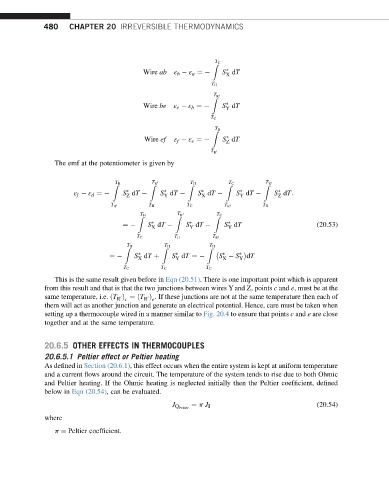Page 488 - Advanced thermodynamics for engineers
P. 488
480 CHAPTER 20 IRREVERSIBLE THERMODYNAMICS
T
Z C
Wire ab ε b ε a ¼ S dT
X
T H
T
Z R 0
Wire be ε e ε b ¼ S dT
Y
T C
T
Z R
Wire ef ε f ε e ¼ S dT
Z
T R 0
The emf at the potentiometer is given by
T
T
T
T
T
Z R Z R 0 Z H Z C Z R 0
ε f ε d ¼ S dT S dT S dT S dT S dT:
X
Z
Y
Z
Y
T R 0 T H T C T R 0 T R
T T T
Z H Z R 0 Z C
(20.53)
¼ S dT S dT S dT
Y
X
Y
T C T H T R 0
T
T
T
Z H Z H Z H
¼ S dT þ S dT ¼ S S Y dT
Y
X
X
T C T C T C
This is the same result given before in Eqn (20.51). There is one important point which is apparent
from this result and that is that the two junctions between wires Yand Z, points c and e, must be at the
same temperature, i.e. ðT Þ ¼ðT Þ . If these junctions are not at the same temperature then each of
0
0
R c
R e
them will act as another junction and generate an electrical potential. Hence, care must be taken when
setting up a thermocouple wired in a manner similar to Fig. 20.4 to ensure that points c and e are close
together and at the same temperature.
20.6.5 OTHER EFFECTS IN THERMOCOUPLES
20.6.5.1 Peltier effect or Peltier heating
As defined in Section (20.6.1), this effect occurs when the entire system is kept at uniform temperature
and a current flows around the circuit. The temperature of the system tends to rise due to both Ohmic
and Peltier heating. If the Ohmic heating is neglected initially then the Peltier coefficient, defined
below in Eqn (20.54), can be evaluated.
¼ p J I (20.54)
J Q Peltier
where
p ¼ Peltier coefficient.

